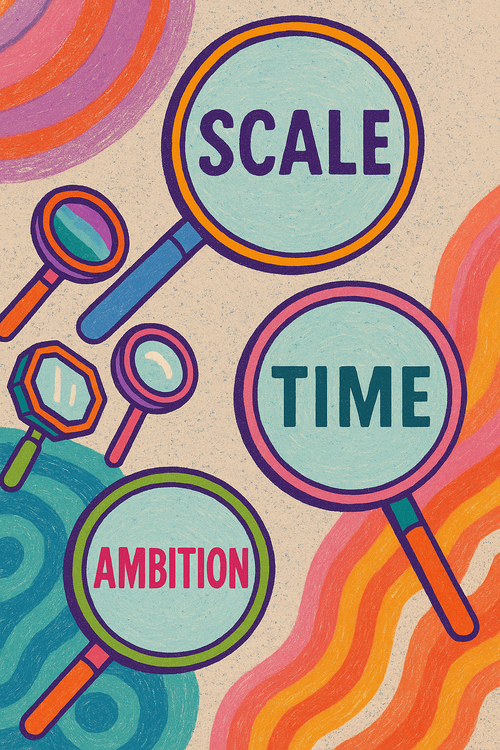Whenever project I am working for on changing cities or organisations, I run ideas through three filters:Scale, Time, and Ambition, in discussing with my clients. Without them, it’s like trying to redesign a neighbourhood with only a sketch on a napkin — you miss the structure that makes everything hold together.

You can't stop a city or an organisation to fix it and make it more sustainable. By enabling Public-Private-Community Partnerships you can solve so many problems for so many stakeholders with fewer resources - this is my philosophy for every project I got involved in, locally or internationally. It's a bit harder to do and you need expertise to facilitate such projects, but totally worth it.
1. The Lens of SCALE
The physical scale of sustainability asks us to think about the 'where.' Are we focusing on global challenges like climate change and ocean conservation, which affect everyone on the planet? Or are we narrowing in on local issues, like urban air quality, community recycling programs, or preserving regional biodiversity? Another layer to this is addressing specific ecosystems—like forests, wetlands, or marine environments—which have unique characteristics and vulnerabilities. Understanding the physical scale helps us prioritize our actions and tailor solutions to the spaces they affect most.
Change begins with the occupant, then the building, then the neighbourhood, the developer, the city, and ultimately the planet. In my experience, people either go too high level, or jump to fast into the details. It's essential to have a broad understanding of the levels you are impacting, now and in the future.
Research backs this up:
- OECD’s Principles on Urban Policy highlight the need for multi-level governance.
- The New European Bauhaus argues transformation only scales when projects cluster at neighbourhood level.
At what scale does your problem really live? And who needs to act at the next scale up for your solution to stick?
Resources:
2. The Lens of TIME
Cities and organisations live in three rhythms: now, next year, and the 5–20 year horizon.
The temporal scale looks at the 'when' of sustainability. Some actions yield immediate benefits, like switching to energy-efficient lighting or reducing single-use plastics. These short-term wins are important for building momentum. But sustainability also requires a long-term vision. For example, restoring degraded ecosystems or transitioning entire industries to renewable energy can take decades, yet these are the projects that deliver profound, lasting impacts. Balancing short-term gains with long-term strategies ensures that our efforts are not only impactful now but also sustainable into the future.
In finance, this often creates tension. Households ask, “How much will I save next year?” Banks ask, “How quickly can we sell this green product?” Policymakers focus on 2030 or 2050 emission targets. Politicians on this year budget, inflations and other short term goals. These timelines clash — and that’s why adoption is slower than the ambition suggests. Negotiating timelines and priorities is hard, but when you did it throughly, it gets closer to implementation.
Research reminds us:
- The IPCC warns about “lock-in effects”: the buildings we construct today will determine emissions for decades.
- McKinsey’s Sustainability as Strategy shows 70% of organisations fail on long-term goals because they optimise for the short term.
Which timeline is driving your decisions today? And which one are you neglecting?
Resources:
- IPCC AR6: Climate Change 2022
- McKinsey: Sustainability as Strategy
- Ellen MacArthur Foundation: Circular Economy in Cities
3. The Lens of AMBITION
Ambition is where scale and time collide. The scale of ambition challenges us to define the 'how.' Should we aim for incremental improvements, such as reducing carbon emissions by 10% per year? Or should we set bold, transformative goals, like achieving net-zero emissions by 2030? Incremental changes may feel more achievable and less disruptive, but they often fall short in addressing urgent crises. On the other hand, bold ambitions inspire innovation and mobilize resources, though they come with higher risks. Deciding on the level of ambition involves balancing feasibility with the urgency of the challenges we face.
I'll use buildings just as an example, You can aim for minimum compliance (nZEB), go further (Passive House), or wider (LEED/BREAM), or push forward (GRESB) for systemic ESG transformation. From my projects, I’ve learned that ambition is contagious. Most of the people don't dream high enough. It takes a bit longer to mobilise resources, but there are enough crazy people to invest in pushing the world forward. I believe at this stage, we lack more the optimism and the courage than any other resources.
Studies show:
- GRESB data finds that organisations with higher ESG ambition outperform peers by 10–15% in risk-adjusted returns.
- Passive House research proves 75–90% energy savings compared to conventional buildings, but only when ambition is embedded from the start.
If your ambition level stayed exactly where it is today, would you be proud of the outcome 20 years from now?
Resources:
Putting It All Together
These three lenses — Scale, Time, Ambition — are the way I make sense of transformation. Whether I’m working with a city hall, a developer, a bank or any other organisation, I ask:
- At what scale does this problem sit?
- Which time horizon am I solving for?
- How much ambition do we dare to put on the table?
It doesn’t make change easy. But it makes it coherent. And coherence is what cities, organisations, and communities need most right now. These three scales offer a framework to assess and design sustainability initiatives. By thinking about where, when, and how we act, we can ensure our efforts are both effective and aligned with the needs of the moment.
Feel free to engage in comments. So many people engage on social media, but that may not remain the best place to engage in meaningful conversations. Let's give this a try. Don't by shy.
PS - Thanks Carla for making me return to writing on my blog after 3 years.

